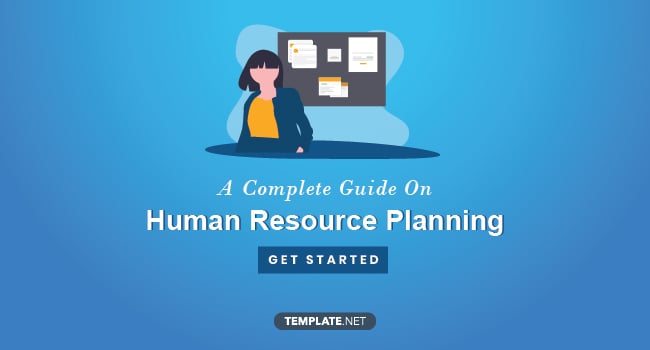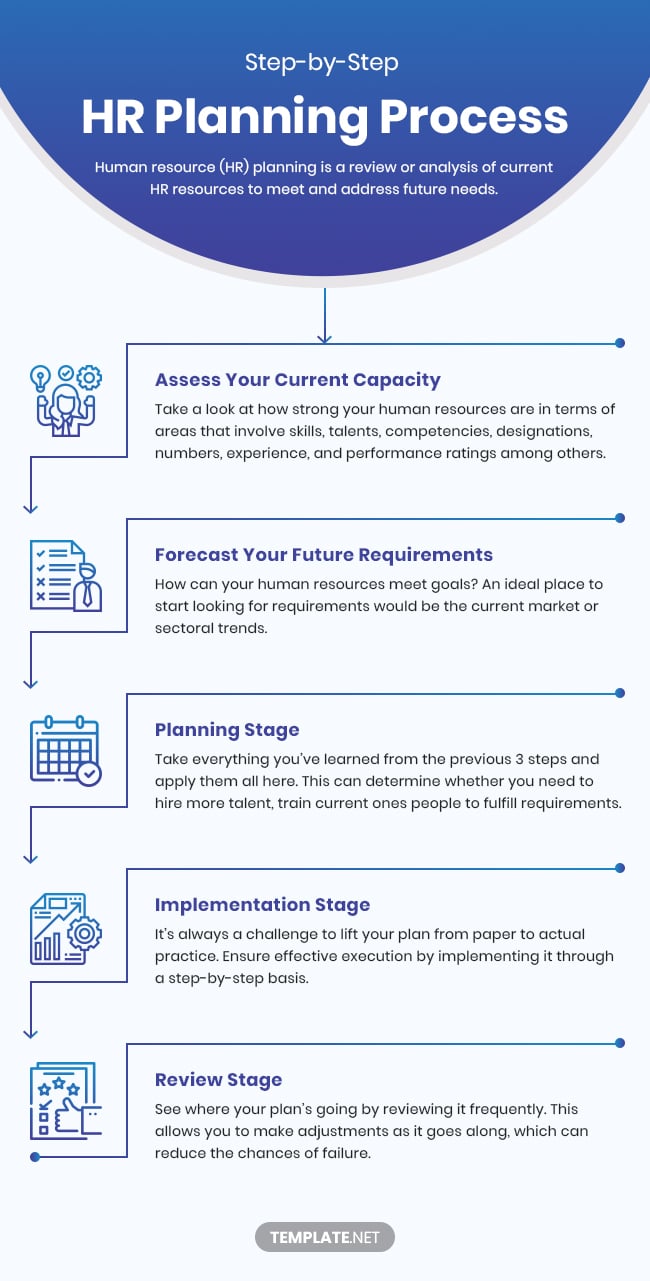A Complete Guide to HR Planning
A Complete Guide to HR Planning
What Is HR Planning?
Human resource (HR) planning is a review or analysis of current HR resources to meet and address future needs. The results of this investigation allow HR teams to forecast future demands and requirements for continuous success. In layman terms, it’s called workforce planning or manpower planning, both of which are essential HR skills. It’s no secret that every business has a specific set of strategic goals they want to meet. Meeting those goals means having the necessary number of people with specific skills at the correct job positions at the right time. It’s on HR teams to pull this off because this is crucial for a business’s future.

Step-by-Step HR Planning Process

By now, you probably know that a business’s most valuable asset is its employees. Their invaluable knowledge and skills are important for propelling one to successful heights. If you don’t have a talent pool, you won’t have people to carry out your venture’s operations for you. Since you’ve already grasped its definition at this point, let’s go over the steps in an HR planning process. These procedures are familiar to HR folks since they’re, well, part of their jobs. But if it’s your first time hearing about this, allow these steps to show you how HR teams assess a workforce.
Assess Your Current Capacity
Before you make any moves, assess the current talent you have at your disposal. Take a look at how strong your human resources are in terms of areas that involve skills, talents, competencies, designations, numbers, experience, and performance ratings among others.
Reviewing previous evaluations isn’t the only way to conduct assessments. You can also carry out this phase by handing out questionnaires to employees for self-evaluation. You can even do a mix of the two methods if you want to. While you’re at this first step, you can reach out to HR managers. They can provide you with good insights on current HR issues they’re facing while giving suggestions on areas that need adjustments.
Forecast Your Future Requirements
You don’t have to be a psychic in this 2nd step. However, you do need to anticipate your business’ or organization’s future needs. How can your human resources meet goals? An ideal place to start looking for requirements would be the current market or sectoral trends. While you’re doing your research, you may want to look at these factors that can make or break your plans: attrition rates, layoffs, retirements, and promotions.
After getting the information you need, the actual forecasting begins. You have to go about it in 2 ways, which will be explained briefly below:
- Supply Forecasting: This will let you know if your current resources can keep up with the demands. Look at your internal and external labor forces (if you have any) to see which employees can step up and fulfill your business’s or organization’s needs.
- Demand Forecasting: This one’s more of a numbers game. How many quality people do you need to meet your corporate goals? Make sure you have a clear and full understanding of your organization’s or business’s objectives. This way, your forecast can be aligned with what needs to be accomplished.
Seek and Fill out the Gaps After Your Inventory
After forecasting potential demands, now’s the time to pick out the existing gaps within your workplace. Ask yourself the following questions as you’re looking for them:
- Can the current number of employees meet your forecasted demands?
- Are their talents and skills being used properly?
- Do you need to beef up your training and development program to help employees meet organizational goals?
Once you’ve found your gaps, fill them up by increasing your talent pool. You can hire people on a full-time, part-time, or even a contractual basis. Make sure the bodies you put on empty seats can keep up with what you’re trying to achieve.
Set Your Plan into Motion
After all the assessments and forecasts are through, it’s time to finally enact your HR plan. Your plan will come to life in these 3 stages:
Planning Stage
Take everything you’ve learned from the previous 3 steps and apply them all here. This can determine whether you need to hire more talent, train current ones, or outsource people to fulfill requirements. Whatever your plan is, it has to have well-defined objectives and clear goals. It also needs to describe the necessary actions you need to take, the outcomes you wish to happen, and the resources you’ll use to take those actions. Don’t forget to set a timeline for your desired outcomes. And lastly, a periodic scope of review should be in place to see your progress through.
Implementation Stage
It’s always a challenge to lift your plan from paper to actual practice. Ensure effective execution by implementing it through a step-by-step basis. As much as we all like to get a lot of things moving in one go, take it slow to brace yourself for any possible challenges. Give your employees some room to embrace changes so they won’t be caught off guard. Don’t forget to comply with relevant legal requirements to steer clear from hitches.
Review Stage
See where your plan’s going by reviewing it frequently. This allows you to make adjustments as it goes along, which can reduce the chances of failure. Have a project management sheet around for convenient monitoring.
Why is HR Planning Important?
HR planning is key to surviving in the world of business. If times and trends change, so do your strategies. You need to plan accordingly so your workforce can meet the goals your business wants to accomplish. You’re welcome to use tools to help you with the planning process. You can also enlist the help of HR dashboards, workforce maps, and historical data to make data gathering easier on your part. As to how long your plan can cover your company’s HR needs, it depends on the goals you’re trying to reach. A short-term plan is enough to satisfy present demands, while long-term plans are suitable for goals that’ll take a while to meet.
The world of human resources is a complex one to navigate. HR planning is a compass you’ll need to get to the direction you want your business to take. If you find yourself lost, now’s the time to craft an HR roadmap that’ll get your business out of a path it doesn’t want to be in.






